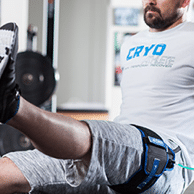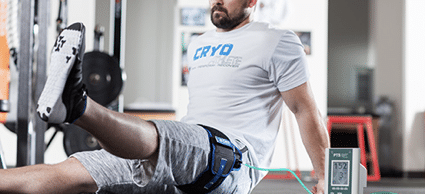
Call to make an appointment today!
Medford~WestBerlin~Haddonfield
My first meeting with Blood Flow Restriction
As many of you know, I am a physical therapist and a sports fanatic! I love to treat athletes and watching them get back to what they love to do, while teaching them some valuable lessons along the way. I have focused my continuing education courses around the latest research and treatment options that help optimize an athlete’s recovery. A few years ago I was watching ESPN and saw an Outside the Lines special on BFR – Blood Flow Restriction – training and how many professional teams were adopting this technology and utilizing it with their players. (See the ESPN clip here https://www.espn.com/video/clip/_/id/15175951 & https://www.espn.com/video/clip/_/id/15162497) I looked into some of the research but at the time, the practice was relatively new and not many studies had been performed. Fast forward 3 years, and now there is a ton of research showing that BFR works in many different ways and is safe.
Recently, a few surgeons who 3DPT works with, reached out to me to see if I started using BFR for any of our physical therapy patients yet. At 3DPT, we are committed to provide the best possible care for our patients and with the research that was now available and surgeons in the area looking for it, I knew I had to get certified in Blood Flow Restriction. In May, I took the ORS (owensrecoveryscience.com) BFR course in Maryland and I was blown away. At the course they presented so much research on the reasons why BFR works and what happens in the body when it is applied. Below I will discuss some of the science behind it and why it is useful in physical therapy, improving athletic performance and preventing injury.
A quick anatomy lesson
Without getting too scientific, a quick anatomy lesson would be helpful to understand the mechanisms behind BFR.
Our bodies have two general types of skeletal muscle fibers: slow-twitch (type I) and fast-twitch (type II).
- Slow-twitch/Type 1
a. Require oxygen as fuel
b. Produce less force
c. Able to maintain longer-term contractions
d. Key for stabilization and postural control - Fast-twitch/Type 2
a. Do not require oxygen
b. Produce high levels of force
c. Fatigue quickly
d. Used in powerful bursts of movements like sprinting
During normal activities, where oxygen in our blood stream is plentiful, we are using slow-twitch, or type 1, muscle fibers. However when we exercise, especially at very high intensity levels, the oxygen in our blood and muscles gets used up quickly, leading us to use of the fast-twitch/type 2 fibers. If we continue to perform the high intensity activity, our body continues to recruit more and more of these type 2 fibers until all fibers have been recruited, leading to muscle failure. It sounds complicated but just think about when lifting weights. Your muscles progressively become more tired and eventually “fail” due to the body not being able to recruit more (consider all this the local response). When this is occurring we are also breaking down muscle tissue and the muscle releases a signal (essentially a cry for help) for the central nervous system (brain and spinal cord) to come to the rescue (systemic/full body response). If you have worked out intensely you know this means increasing heart rate, ventilation and sweating. Hormones that help in the repair and rebuilding processes of the muscle are also released throughout your body during and following high intensity exercise. The most abundant being human growth hormone (HGH) and insulin-like growth factor (IGF).
For the body to truly build bigger and stronger muscles we need to have more muscle protein- building then muscle protein-breakdown.
SO…What if there was a way we could recruit and fatigue these fast-twitch/type 2 fibers and cause those muscle building hormones to be released, without having to break them down with high intensity exercises and heavy loads???? Or what if there was a way to truly strengthen and build our muscles right after surgery or injury, when we are unable to lift heavy loads?
DRUM ROLL PLEASE…. Introducing BFR, or Blood Flow Restriction

What is BFR?
BFR is a rehab intervention and performance enhancing tool that uses the body’s natural systems of stress and recovery that we talked about above. Trained healthcare professionals use an FDA-approved tourniquet on a specific part of the body to restrict 50-80% of venous blood flow. By reducing blood flow, we can create positive effects that will allow for increased muscle growth and strength that you would traditionally need a heavy load to achieve. Research on traditional resistance training requirements for muscle growth suggests loads heavier than 65% of an individual’s one rep max (1rm) must be used to create hypertrophy gains. So to keep it simple, a person who can squat 100lbs 1 time must squat more than 65lbs to create muscle growth and improve strength. With BFR, working out at just 20% of this 1 rep max (20lbs in the example above) allows for the same growth in muscle mass!! SO, performing exercises with BFR will allow you to rehabilitate more aggressively and decrease muscle atrophy (weakness), even when you have weight bearing restrictions, following a surgery or injury. Because little damage is done to the muscles by avoiding heavy weight lifting, improvements in strength and endurance can come quicker = faster recovery!
BFR and Physical Therapy
There is more and more evidence supporting the use of BFR in physical therapy, especially for those too elderly, frail or injured to engage in traditional strength training exercises. Injured individuals often cannot put too much weight on a muscle or joint but need to build bigger and stronger muscles. BFR solves this problem and because of those great hormone responses discussed above, we’ve seen rapid changes in many injuries such as tennis elbow, patellar tendonitis, and muscle strains. Even after surgery, during periods of non-weight bearing, BFR has been shown to be highly effective at minimizing the loss of strength and muscle mass. When post-surgical patients cannot perform exercises with heavy weight, BFR solves the strength problem, without using any exercises outside the surgeon’s protocol. Now those low level “strength” moves you are limited to during early rehab can actually create strength and muscle mass gains.
Here is a quick example of a study that showed the incredible impact that BFR can have on general exercise:
(Clarkson et al 2017)
In this study, sedentary, elderly adults (men and women in their 60s & 70s) walked with and without BFR for 6 weeks (4 walks per week, 24 total walks). The study measured common functional measures of strength, mobility, balance and endurance (the timed-up and go test, the 6-minute walk test, the 30 second sit-stand test, and the modified Queens College Step Test) at the start of the program, at 3-weeks and at 6-weeks.
The BFR walking group saw a 2.5 to 4.5 times greater improvement in their measures of physical function compared to the non-BFR walking group. That’s 250% to 450% greater gains in strength, endurance, balance and mobility just by adding Blood Flow Restriction to the walking. That. Is. Amazing.
BFR Beyond PT
Evidence also shows the benefits of using BFR to:
- Prevent injury- due to release of growth hormone discussed above which will strengthen tendons and improve muscle structure.
- Recovery- Improve muscle recovery after sporting events or after long races for the endurance athlete
- Improve Endurance- Improved VO2 max with use of BFR
All of the benefits above could potentially help athletes, weight lifters, runners, cyclists, crossfit athletes and many others, improve performance and prevent injury.
How does it feel?
While at my certification course, I was able to try the cuffs out on myself. The set up is easy – the cuff was velcroed tightly to my upper thigh and the machine pretty much does the rest. It is equipped with a doppler to measure blood flow and the pressure increases to determine how much is required to restrict 100% blood flow and quickly backs down to 80%. This is where the magic happens! I completed straight leg raises (locking the leg straight and then lifting it while keeping it straight) in a series of repetitions, 30/15/15/15 with 30 second breaks in between each set. The first set wasn’t too hard but I did feel more tired than anticipated. Each set following became progressively harder and the muscle burn in my quad and hip flexor became more intense like I was performing heavy squats! I took a 5 min rest and then performed knee extensions sitting off the edge of the table (sitting and kicking the leg straight) and again the burn in my quad was intense. I woke up the next day with sore legs, like I had completed a full workout, when in reality I had only performed 2 easy exercises that are typically used at the very beginning of a knee strengthening program, proving that the muscles really was working and being built!
We are excited to be offering this game changing technology and rehab tool to 3DPT and believe it will benefit many patients. If you are interested in learning more about Blood Flow Restriction, call to make an appointment today!
Call to make an appointment today!
Categorized as: Articles,Sports Injury